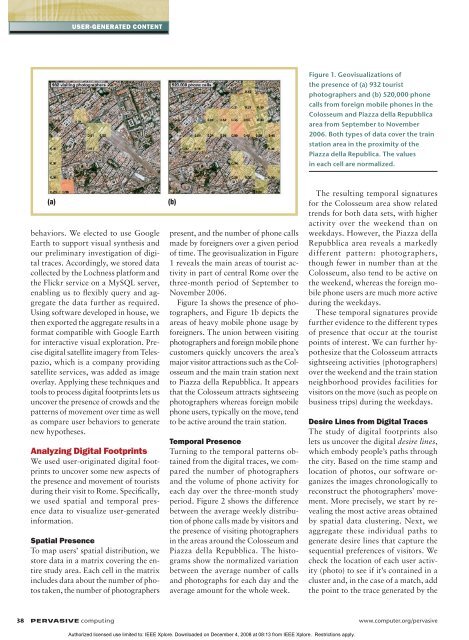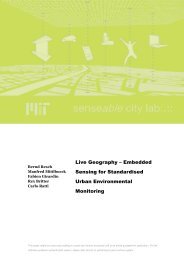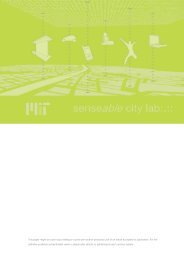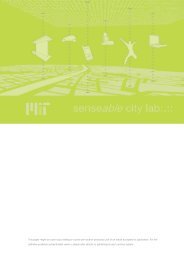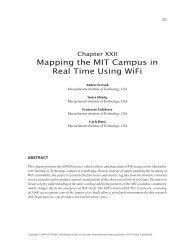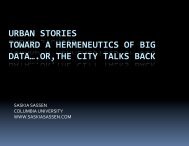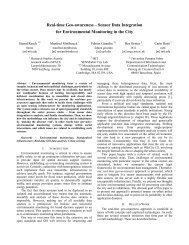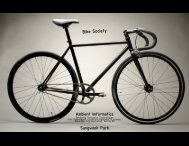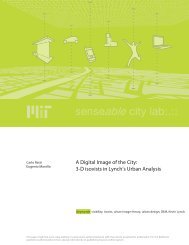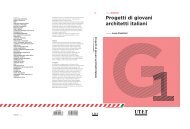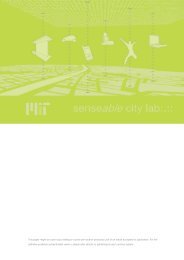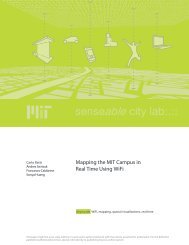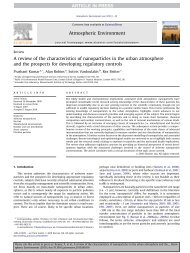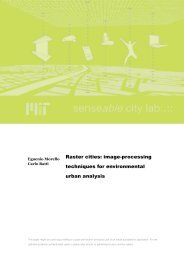Today - MIT SENSEable City Lab
Today - MIT SENSEable City Lab
Today - MIT SENSEable City Lab
You also want an ePaper? Increase the reach of your titles
YUMPU automatically turns print PDFs into web optimized ePapers that Google loves.
User-Generated Content<br />
Figure 1. Geovisualizations of<br />
the presence of (a) 932 tourist<br />
photographers and (b) 520,000 phone<br />
calls from foreign mobile phones in the<br />
Colosseum and Piazza della Repubblica<br />
area from September to November<br />
2006. Both types of data cover the train<br />
station area in the proximity of the<br />
Piazza della Republica. The values<br />
in each cell are normalized.<br />
(a)<br />
behaviors. We elected to use Google<br />
Earth to support visual synthesis and<br />
our preliminary investigation of digital<br />
traces. Accordingly, we stored data<br />
collected by the Lochness platform and<br />
the Flickr service on a MySQL server,<br />
enabling us to flexibly query and aggregate<br />
the data further as required.<br />
Using software developed in house, we<br />
then exported the aggregate results in a<br />
format compatible with Google Earth<br />
for interactive visual exploration. Precise<br />
digital satellite imagery from Telespazio,<br />
which is a company providing<br />
satellite services, was added as image<br />
overlay. Applying these techniques and<br />
tools to process digital footprints lets us<br />
uncover the presence of crowds and the<br />
patterns of movement over time as well<br />
as compare user behaviors to generate<br />
new hypotheses.<br />
Analyzing Digital Footprints<br />
We used user-originated digital footprints<br />
to uncover some new aspects of<br />
the presence and movement of tourists<br />
during their visit to Rome. Specifically,<br />
we used spatial and temporal presence<br />
data to visualize user-generated<br />
information.<br />
Spatial Presence<br />
To map users’ spatial distribution, we<br />
store data in a matrix covering the entire<br />
study area. Each cell in the matrix<br />
includes data about the number of photos<br />
taken, the number of photographers<br />
(b)<br />
present, and the number of phone calls<br />
made by foreigners over a given period<br />
of time. The geovisualization in Figure<br />
1 reveals the main areas of tourist activity<br />
in part of central Rome over the<br />
three-month period of September to<br />
November 2006.<br />
Figure 1a shows the presence of photographers,<br />
and Figure 1b depicts the<br />
areas of heavy mobile phone usage by<br />
foreigners. The union between visiting<br />
photographers and foreign mobile phone<br />
customers quickly uncovers the area’s<br />
major visitor attractions such as the Colosseum<br />
and the main train station next<br />
to Piazza della Repubblica. It appears<br />
that the Colosseum attracts sightseeing<br />
photographers whereas foreign mobile<br />
phone users, typically on the move, tend<br />
to be active around the train station.<br />
Temporal Presence<br />
Turning to the temporal patterns obtained<br />
from the digital traces, we compared<br />
the number of photographers<br />
and the volume of phone activity for<br />
each day over the three-month study<br />
period. Figure 2 shows the difference<br />
between the average weekly distribution<br />
of phone calls made by visitors and<br />
the presence of visiting photographers<br />
in the areas around the Colosseum and<br />
Piazza della Repubblica. The histograms<br />
show the normalized variation<br />
between the average number of calls<br />
and photographs for each day and the<br />
average amount for the whole week.<br />
The resulting temporal signatures<br />
for the Colosseum area show related<br />
trends for both data sets, with higher<br />
activity over the weekend than on<br />
weekdays. However, the Piazza della<br />
Repubblica area reveals a markedly<br />
different pattern: photographers,<br />
though fewer in number than at the<br />
Colosseum, also tend to be active on<br />
the weekend, whereas the foreign mobile<br />
phone users are much more active<br />
during the weekdays.<br />
These temporal signatures provide<br />
further evidence to the different types<br />
of presence that occur at the tourist<br />
points of interest. We can further hypothesize<br />
that the Colosseum attracts<br />
sightseeing activities (photographers)<br />
over the weekend and the train station<br />
neighborhood provides facilities for<br />
visitors on the move (such as people on<br />
business trips) during the weekdays.<br />
Desire Lines from Digital Traces<br />
The study of digital footprints also<br />
lets us uncover the digital desire lines,<br />
which embody people’s paths through<br />
the city. Based on the time stamp and<br />
location of photos, our software organizes<br />
the images chronologically to<br />
reconstruct the photographers’ movement.<br />
More precisely, we start by revealing<br />
the most active areas obtained<br />
by spatial data clustering. Next, we<br />
aggregate these individual paths to<br />
generate desire lines that capture the<br />
sequential preferences of visitors. We<br />
check the location of each user activity<br />
(photo) to see if it’s contained in a<br />
cluster and, in the case of a match, add<br />
the point to the trace generated by the<br />
38 PERVASIVE computing www.computer.org/pervasive<br />
Authorized licensed use limited to: IEEE Xplore. Downloaded on December 4, 2008 at 08:13 from IEEE Xplore. Restrictions apply.


